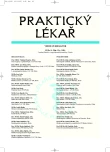Symptoms of paraneoplastic encephalopathy as the first clinical sign of Hodgkin’s lymphoma. A case study
Authors:
Z. Rusiňáková; L. Raida; K. Indrák
Authors‘ workplace:
Prednosta: Prof. MUDr. Karel Indrák, DrSc.
; Hemato-onkologická klinika LF UK Palackého
a Fakultní nemocnice Olomouc
Published in:
Prakt. Lék. 2007; 87(2): 114-116
Category:
Case Report
Overview
Limbic encephalopathy and subacute cerebellar degeneration are rare paraneoplastic autoimmune epiphenomena associated with Hodgkin’s lymphoma. Only a few cases have been reported in the literature. This report describes the case of a 19 year old female, whose neurological symptoms resulted from a paraneoplastic encephalopathy and became one of the first and dominant clinical manifestations of Hodgkin’s lymphoma. Diagnosis of paraneoplastic encephalopathy was concluded after exclusion of neuroinfection, primary demyelinating disease of the central nervous system and it was based on complete neurological restoration, followed by remission of lymphogranuloma achieved by combined chemotherapy in primary treatment.
Key words:
Hodgkin’s lymphoma, encephalopathy, central nervous system, autoimmunity, therapeutic response.
Labels
General practitioner for children and adolescents General practitioner for adultsArticle was published in
General Practitioner

2007 Issue 2
Most read in this issue
- Risk of malnutrition and nutritional support in Alzheimer disease
- Active search for prostate cancer by PSA testing in GP surgery
- The legacy of I. F. Semmelweis; key milestones in the development of hospital hygiene and current challenges.
- Symptomatic diabetic neuropathy: irreversible nerve damage?
